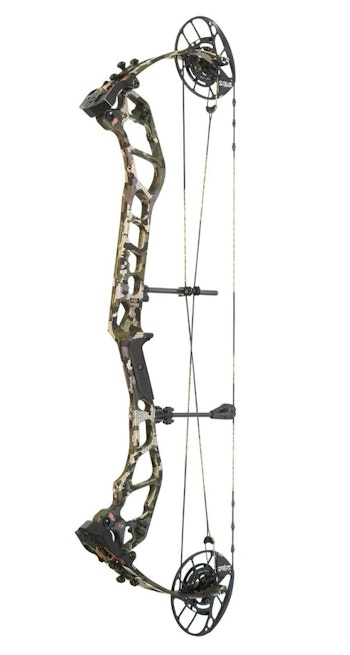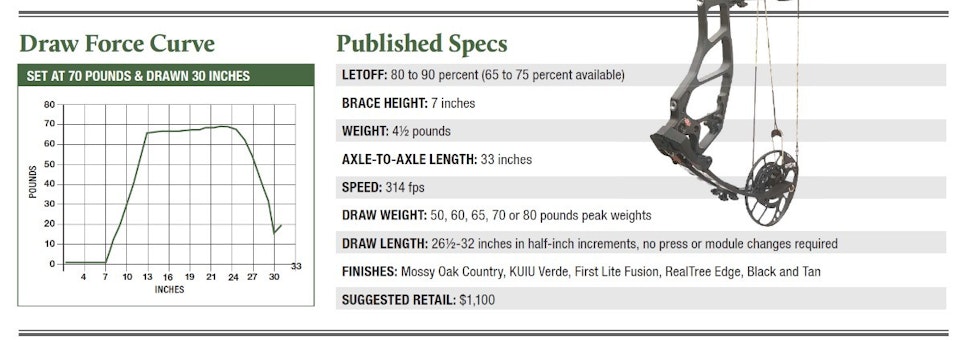“I think we have squeezed about all the efficiency we’re going to get out of the bow machine. Going forward, it’s going to be all about what I call ice cream bows — compounds that are super-smooth shooting.” PSE’s Pete Shepley said that to me more than 10 years ago, and his words have proved prophetic.
Manufacturers who not that long ago seemed to be competing to produce the world’s fastest compound bow now seem to be competing to produce, if not the world’s smoothest-shooting bow, at least a bow that hits the elusive sweet spot. A bow that’s reasonably fast and exceptionally pleasant to shoot, with a smooth draw cycle, high letoff, low noise and little, if any, vibration.
Of course, one bowhunter’s sweet spot is a 250 fps barnburner that is more shootable than just about any compound manufactured 10 years ago. Another hunter’s sweet spot is a 220 fps bow that may not have the flattest trajectory, but that will still effectively harvest any North American big game animal, and is as smooth-drawing, quiet and generally pleasant-shooting as a hunting bow can be. With a 2020 line-up that includes 19 compound hunting bows (in addition to numerous target bows, recurves and longbows) PSE has this advantage over its competitors: Rather than seeking a common denominator with a handful (or less) of bows, it can create niche bows — that is, a variety of bows each designed to appeal to a different set of preferences. Where does the PSE Evo NXT 33 fit in? With a published speed of 314 fps, this offering is clearly designed to appeal to the growing number of bowhunters who place a premium on pleasant-to-shoot over super-fast, flat-shooting bows.
PSE’s popular Evolve cam system is at the heart of this bow, offering an adjustable letoff from 80 to 90 percent, as well as a wide draw range of 26½-32 inches. A yoked cable system minimizes cam lean. The Wedge-Lock limb pockets are retained as well, but there are numerous new design features on this bow. The riser is proportionately long and lacks the cage from previous models, making the bow more stable and less top heavy. A second stabilizer mount, near the bottom of the riser, provides increased stability, especially for those who shoot with quivers mounted to the bow. A rear stabilizer mount allows even further tweaking of balance. Parallel limbs, along with the longer stabilizer, decrease noise and hand vibration. The cable guard is straight, as opposed to the flexible cable guards of recent years, but can be moved in or out to adjust for torque, and rollers on the guard itself act to reduce cable friction to an absolute minimum. Finally, the grip is new and different for PSE. It’s much wider, with a flatter back, and is a rubber-like synthetic. I found it comfortable, and it will certainly be warmer in cold weather. It can be removed for shooters who prefer a skinnier grip.
Fit and finish is the kind of high quality you’d expect from a PSE flagship bow. In terms of appearance, if you like a bow with a long riser and short limbs, you’ll love it. Certainly the quality of finish and the camo options for this bow enhance its overall look.
Shooting the PSE Evo NXT 33
There is nothing in the riser design of PSE compound bows that makes installation of accessories difficult, and all accessories were installed without difficulty. Limb bolts were a little snug, but turned without sticking, slipping or chattering. Draw length is 29 inches out of the box; this was adjusted, without difficulty, to the IBO standard 30 inches. The bow tuned well with the rest at centershot; I did tweak the cable guard slightly to correct a slight right tear in paper.
The most noticeable features upon picking up the bow are its weight and the new grip. At 4½ pounds, the Evo NXT 33 is not an inordinately heavy bow, but cannot be called light, either. The synthetic grip is comfortable and would be welcomed on cold days afield, but as mentioned previously, it is removable for those who prefer a skinny grip. In a new era of smooth-drawing bows, the draw cycle of this bow is exceptionally smooth. It drops nicely into the valley without a bump at the end. The back wall is plenty firm, and though the valley is not particularly deep, the cams are not in the least, “grabby.” At the shot, the bow moves forward slightly in a properly loose grip, but there is virtually no vibration; this is a super-quiet bow. To the extent a bow can be described as dead in the hand, this bow falls into that category. Bowhunters who like the pop and the flatter trajectory of a true speed bow might find this bow lacking, but those who are looking for a pleasant-shooting, quiet and forgiving hunting bow need look no further than the PSE Evo NXT 33.
Sidebar: How We Test
- Each bow is carefully inspected out of the box for fit and finish and for any visible defects in workmanship. Axle-to-axle length, brace height, mass weight and draw length are measured and compared with stated specs. Minor discrepancies in draw length are corrected or noted. A QAD UltraRest is installed, and each bow is equipped with a TruGlo sight, a TruGlo stabilizer, a G5 1/4-inch Metapeep and a D-loop.
- Test arrows are Carbon Express Maxima Red arrows at weights of 385 and 440 grains, fletched with Bohning Blazer vanes and fitted with QAD Tune-A-Nocks. Peak draw weight is established, and draw force curves, along with letoff, are determined using an Easton Bow Force Mapping System.
- Using a Spot-Hogg Hooter Shooter bow-shooting machine and a ProChrono chronograph, arrow speed and kinetic energy are measured at point of launch and at 20 yards.
- Sound is measured with an NM102 Sound Level Meter with mic positioned 3 feet in front of the bow and 18 inches under the arrow flight path.
- All bows are pressed on a Buckeye Archery Solutions Bow-A-Constrictor press.









